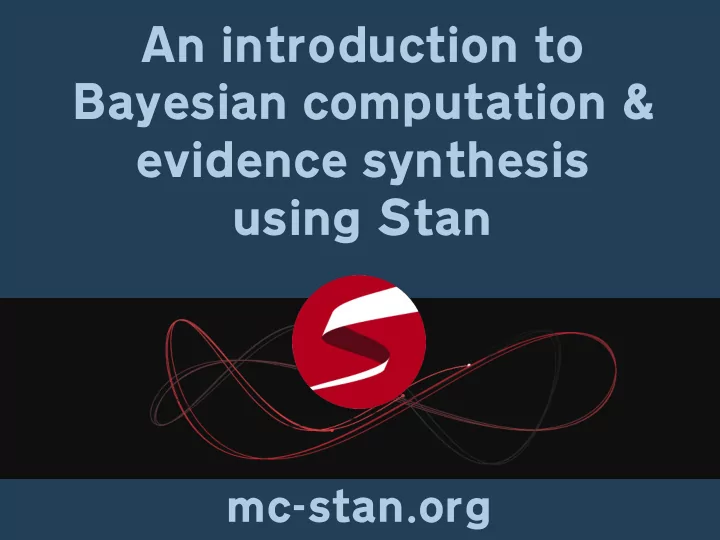

An introduction to Bayesian computation & evidence synthesis using Stan mc-stan.org
About the speaker Robert Grant is senior lecturer in health & social care statistics at Kingston University & St George's, University of London, UK Wrote the StataStan interface Interested in Bayesian latent variable models robertgrantstats.co.uk
Bayesian computation Computer-intensive methods Simulation Metropolis algorithm (40s) Metropolis-Hastings algorithm (70s) Gibbs sampler (80s) Hamiltonian Monte Carlo (80s)
Bayesian software M-H / Gibbs: BUGS, JAGS, JASP, SAS (proc mcmc), Stata (bayesmh) Hamiltonian MC: Stan
Hamiltonian Monte Carlo Speed (rotation-invariance + convergence + mixing) Flexibility of priors Stability to initial values See Radford Neal's chapter in the Handbook of MCMC
Hamiltonian Monte Carlo Tuning is tricky One solution is the No U-Turn Sampler (NUTS) Stan is a C++ library for NUTS (and variational inference, and L-BFGS)
http://www.stat.columbia.edu/ ~ gelman/research/published/nuts.pdf
Some Stan model code data { int N; real y[N]; real x[N]; } parameters { real beta[2]; real<lower=0> sigma; } model { real mu[N]; beta ~ normal(0,50); sigma ~ normal(0,20); for(i in 1:N) { mu[i] <- beta[1] + beta[2]*x[i]; } y ~ normal(mu,sigma); }
rstan stan(file = ‘ model.stan ’ , data = list.of.data, chains = 4, iter = 10000, warmup = 2000, init = list.of.initial.values, seed = 1234)
CmdStan make "C: \ model.exe" model.exe sample data file="mydata.R" stansummary.exe output.csv
StataStan global cmdstandir "C:/cmdstan-2.9.0" quietly count global N=r(N) stan y x1 x2 x3, modelfile("model.stan") /// cmd("$cmdstandir") globals("N")
Some simulations Collaboration with Furr, Carpenter, Rabe- Hesketh, Gelman arxiv.org/pdf/1601.03443v1.pdf rstan v StataStan v JAGS v Stata More recently: rstan v rjags robertgrantstats.co.uk/rstan _ v _ jags.R
Rasch model (item-response) Hierarchical Rasch model (includes hyperpriors)
StataStan vs Stata vs rjags
rstan vs rjags Seconds: Rasch H-Rasch rstan 180 210 rjags 558 1270 ESS (sigma): Rasch H-Rasch rstan 22965 21572 rjags 7835 8098 ESS (theta1): Rasch H-Rasch rstan 32000 32000 rjags 19119 19637
rstan vs rjags
rstan vs rjags
Evidence synthesis Bayesian models can go beyond crude approximations Different statistics Different metrics Different scales Other uncertainty & bias
Coarsened data See Heitjan & Rubin 1990 Given proportion achieving a threshold at endpoint, and baseline statistics, we can work out a posterior conditional distribution for the endpoint means. We may have to assume, model or simulate SDs, correlation...
Test case Cochrane review of tricyclic antidepressants in children (latest update: Mizraei et al 2013) 13 trials, sample size between 6 and 173 8 trials: mean differences & responders, one responder only Mostly relative-ratio, but some ambiguity
Simula mulation tion st study
Simula mulation tion st study
Simula mulation tion st study
Cochrane review results From Mizraei et al: mean reduction (SMD) of 0.32 CI 0.04 to 0.59 risk ratio for responding: 1.07 CI 0.91 to 1.26 From the Bayesian model: mean reduction (on CDRS scale) of 3.8 points CI 2.4 to 5.4
A more complex setting Review of psycho-social benefits of exercise in osteoarthritis Lots of differences among studies Change from baseline vs endpoint Duration of intervention A structural equation model
Getting started mc-stan.org stan-users Google Group
Recommend
More recommend